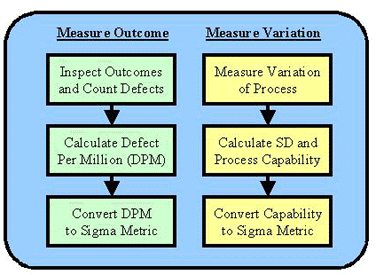Advanced Quality Management / Six Sigma
Six Sigma Basics: Outcome Measurement of Process Performance
Six Sigma saves you money when you can reduce defects. But how do you find those defects? Dr. Westgard gives you a step-by-step method of analyzing your tests, identifying waste, calculating sigma-metrics, and more. (preview)
- Two Approaches for Measuring Process Performance
- A Well Known Example
- DPM Conversion Table
- Laboratory Performance Indicators as Outcome Measures
- Benchmarks for Process Performance
- Measurement Considerations
- What's the point?
- References
Six Sigma Quality Management provides a general goal for process performance - six sigmas of process variation should fit within the tolerance limits or quality requirement for the product. Given this goal, it is important to measure process performance to determine whether improvement is needed. There are two different methodologies - one based on counting the defects produced by the process (an outcome measure) and the other based on measuring the variability of the process directly (a predictive measure).
Two Approaches for Measuring Process Performance
The two approaches are illustrated in the accompanying figure. The first approach is based on the measurement of the outcome of the process, whereas the second is based on measurement of the variation of the process. The outcome measurement approach is applicable to any process, but usually requires extensive efforts to collect and analyze the data. Direct measurement of process variability allows for determination of process capability. This approach assumes a process whose distribution is stable and can be characterized by repetitive measurements. This second approach is more limited in application, but is advantageous in order to plan, design, evaluate, and optimize process performance prior to routine operation and production.

This lesson is about the first methodology that inspects the output of the process, estimates the defect rate in terms of defects per million (DPM), then converts the defect rate to a sigma-metric to characterize process performance.
 Want to read more of this article?
Want to read more of this article?
We invite you to purchase the Six Sigma QC Design and Control manual, Second Edition, available at our online store. You can also download the Table of Contents and a Sample chapter.
